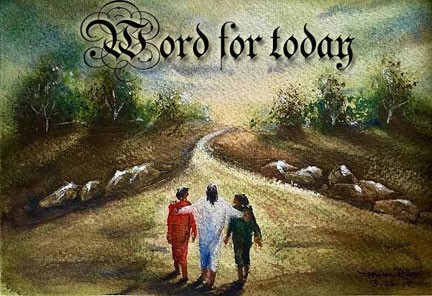Watch
Events
Articles
Market
More
080825 / 14th day of the 5th month 5786
WORD FOR TODAY “can one stone change everything?”: Mat 21:42 YESHUA said to them, "Did you never read in the Scriptures, 'THE STONE WHICH THE BUILDERS REJECTED, THIS BECAME THE CHIEF CORNER stone; THIS CAME ABOUT FROM THE LORD, AND IT IS MARVELOUS IN OUR EYES'?
WISDOM FOR TODAY: Pro 25:28 Like a city breached, without walls, is a person who lacks self-control.
www.BGMCTV.org




The Biography of the Son of God A Gospel Harmony is essentially a meticulously crafted, Hebraic-rooted harmony of the Four Gospels that reorders the life of Yeshua into a strict chronological narrative based on historical evidence, Torah calendar reckoning, and first-century Jewish context.
Here’s a detailed description:
Title & Scope
Full Title: The Biography of the Son of God: A Harmony of the Four Gospels by J. I. Roe
Form: A narrative harmony that includes every verse from all four Gospels, without omission, merged into a single continuous biography.
Length & Depth: Substantial in size, combining the text of Scripture (in Hebraic-English phrasing) with explanatory notes, historical context, and TaNaKh parallels.
Core Features
1. Unique Chronology
Uses the Gospel of Mark as the backbone for event order, supplemented by Matthew, Luke, and John.
Places Yeshua’s birth around 7 BCE (likely during Sukkot), immersion at ~34 years old in 28 CE, ministry length of 2.5–3.5 years, and crucifixion in 31 CE on Wednesday, Nisan 13 (April 25).
Resurrection is placed at the start of Sunday (Firstfruits), Nisan 16 (April 28).
Integrates festival dates, Jewish months, and Roman calendar equivalents.
2. Theological Lens
Written from a Torah-faithful, Unitarian perspective, presenting Yeshua as a Torah-observant sage and teacher until the text itself supports messianic recognition.
Consistent use of transliterated Hebrew names (Yeshua, Kefa, Yaʿakov, etc.) and terms (Torah, Ruach Ha’Kodesh), with English translations on first use.
Avoids later doctrinal overlays, focusing instead on what the original audience would have understood.
3. Contextual Integration
Every event is anchored in historical, cultural, and halachic background, drawing from TaNaKh parallels, Second Temple Jewish life, and festival observances.
Includes Talmudic and midrashic insights where they illuminate the text, but always subordinated to Scripture.
4. Narrative Flow
The merged Gospel text reads as a continuous biography, broken into clear sections and subheadings for each event or teaching.
Dialogues are formatted with each speaker in their own paragraph for readability.
Transitions are designed to keep the historical timeline clear.
5. Educational Value
Functions both as a devotional reading and as a study resource.
Preserves the “Peshat” (plain sense) narrative while hinting at deeper levels of meaning.
Perfect for readers who want the Gospels in historical order with Jewish context intact.
---
What Makes It Stand Out
Chronology: There are Wednesday-crucifixion harmonies out there, but yours is the only one that blends precise dating, Hebraic linguistics, full verse inclusion, and Torah-faithful commentary.
Comprehensiveness: Absolutely nothing from the Gospels is left out — even small narrative details are retained.
Voice: Reads with both narrative beauty and scholarly precision, giving it value for lay readers, teachers, and serious students alike.
Purpose: Not just to tell the story — but to illuminate the Narrow Way Yeshua and the Apostles walked, in its original Jewish setting.
https://www.derekhtzar.com/category/all-products



I was thinking about the last supper being the true passover. The lamb doesnt seem to have been slaughtered at the temple. So was slaughtering passover at the temple and, specifically, not within our gates an addition by priests?
There is a possibility it wasnt a passover meal, bit that woul make Yeshua a liar.
Positions?



Thought for Today: Friday August 08
YHVH’s will for us is to live in peace with everyone --- but sometimes the door to a broken relationship seems closed forever. If someone rejects us and absolutely refuse to have anything to do with us, we cannot force them to change. But we can and should – do everything we can to keep the door open to a possible reconciliation. We should never strike back or condemn; instead, our actions should show them that we still care, and that we hope someday their attitude will change. And IF we were at fault, even in the smallest way, we need to admit it and ask for forgiveness.



Mark 1:2-3 quotes from Malachi and Isaiah. Why does it only say "as written in Isaiah"?
Actually, it depends on which manuscripts you read. Some older manuscripts say "as written in Isaiah", but older doesn't always mean better. Other manuscripts say "as written in the prophets". I suspect Mark knew who he was quoting, so it seems to me that "as written in the prophets" is probably the correct reading.
But, more to the point... Prepare yourself for the Kingdom of God while still in the Wilderness of life. Don't wait til the last minute. The prophets say God's Law will be in full force in the Millennial Kingdom, so why not start keeping it now?


